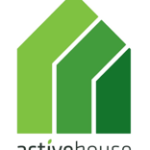Maison verte

Comfort:
The building envelope is entirely realized through a light-weight dry construction system, where each chosen layer is the result of a design optioneering process, aiming the optimization of costs-performances criteria for every technical solution. The relevant thickness of the thermal insulation ensures a very high value of airtightness and contributes to the indoor thermal balance. Besides, the orientation and sizing of openings optimize the solar gains in winter and ensure a very good DF level. In the flat roof, 5 large roof windows provide a distributed bright-ness which increases significantly the lighting quality of the attic. The indoor panels of ceilings and walls help to keep the air clean and healthy, while the windows opening activates the natural ventilation, refreshing the air.
Example: It has been a basis design parameter to have a minimum daylight level of 5% and it has been reached by use of daylight from minimum two orientations in all main rooms. All glazing areas towards the south and west have to be shaded during warm periods and is supplemented with natural ventilation and thereby the indoor thermal comfort level during hot periods. The air quality in all main rooms is controlled when occupied and the ventilation is optimized to keep the CO2 level and humidity low.
Energy:
The envelope design adopts innovative and energy-efficient technical solutions, based on dry construction systems. An additional multi-layered reflective insulation produced by Actis was installed internally in order to increase the capacity to store the energy in winter. A wide flat green roof covers the building, providing a massive shelter able to increase the thermal capacity of the envelope and de-crease the temperature picks during the hottest months. A 3 kWp photovoltaic field will be installed on the flat roof, providing also an effective shading system during the summer. Moreover, four evacuated tube solar collectors for the pro-duction of hot water will the heat for service use.
Example: The basic focus within energy has been to minimize the use of energy and to optimize the building design. The heat loos through the climate shell has been minimized using the best insulation solutions, reduce thermal bridges and creating an air tight construction. Thereby the need for energy has reached a level of 20 kWh/m2 and with the supplementary use of energy for hot water, ventilation light etc., the overall energy use is below 40 kWh/m2. By the use of a heat pump with a COP of 3.5, the final need of energy has reached a level of 20 kWh/m2. The supply of electricity is based on 50% renewable energy in the grid and the supplementary renewable energy are supplied with PV installed on the garage.
Environment:
The adoption of a lightweight dry construction system ensures the rapidity of the construction and minimize the loads on foundations. Moreover, a lightweight structure can be easily disconnected at the end of the building service life and re-assembled for a new life. The choice of the materials was defined through a holistic LCA approach.
Example: The design on the load bearing structure has been based on an expectation that the concrete structure will be reused when the building is out of use after 100 years. The outer surface is based on a wooden structure that are ventilated and protected from direct rain, reducing the need for surface treatment. The wood used are certified and comes from forests that are FSC certified. In order to reduce the use of water a structure for use of rain water for toilets and gardening has been established.


